“I fly because it releases my mind from the tyranny of petty things.”
– Antoine de Saint-Exupery
Coming off the most intense training regimen I've experienced since pilot training back in the 80s. A lot to unpack.
On Friday a thick line of thunderstorms tore through the DFW metroplex, which meant it was a ground training day for Skip and me. We spent several hours in a dimly lit conference room at the FBO in Arlington, going over a powerpoint of diagrams and photos of all the aircraft systems on the Columbia 400, with each official text supplemented by Skip's account of what happens when this component or that fails.
"See that push-pull rod on the flap actuator? It's designed to save the assembly by failing to half flaps if you try to throw down full flaps and you're going too fast. If you have to replace it, the part costs $3,000.00. Don't overspeed the flaps."
Good advice. This aircraft is, like most planes, full of simple-looking mechanical gizmos that cost anywhere from $1,500 to $9,000.00 or more if they quit. You're not going to crash--it's really hard to get the Columbia 400 to do that. You will, however, get your breath taken away when it's time to go to the shop.
We also walked the Van Bortel maintenance hangar, picking around other 400s in various states of undress, Skip pointing out parts we'd seen on slides or interesting modifications the owners had made to their planes.
Then we sat in the cockpit of my new bird on external power, rain pelting the metal hangar roof overhead, Skip frequently and wearily dropping his face into his hands as I bungled the sequence of button pushing on the G1000, over and over.
The next day's flying didn't go much better. We arrived at the plane by 9, and flew until after six. It was a grueling day, Skip trying to pack several days' worth of instruction into a few hours. We flew to Mineral Wells, where there was a giant King Air parked out front and a very well dressed fellow in cowboy boots standing at the bottom of the ladder--that would be the owner, not the pilot.
The folks in the FBO were nice, but the lack of coffee was disappointing.
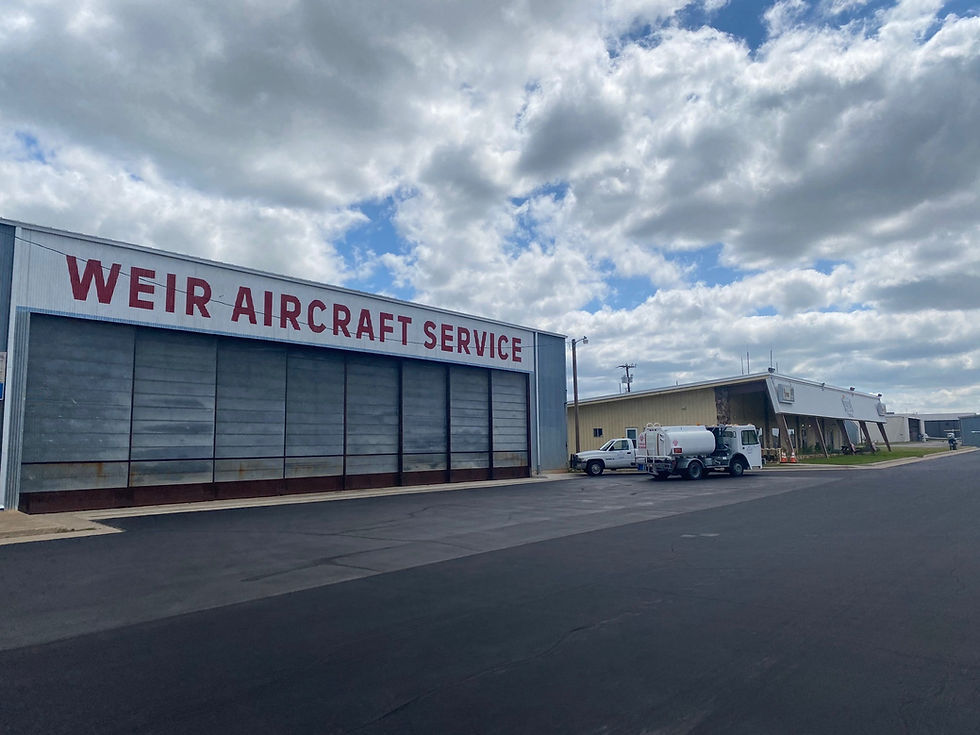
We went other places, but it's all a blur now. We shot an approach or two into Granbury, then did the same at Bridgeport Muni, where we stopped for gas and Skip went inside to jawbone with the old men hanging around on Saturday morning drinking coffee and talking about airplanes. I fumbled with a gas pump that looked vaguely like the one back in Perry, but with a switch or two in different places that made operating it a puzzle. I started to question for the first time whether my 56-year-old brain could absorb so much new stuff. Maybe I just lack the neural plasticity to get there.
Skip brought me a couple blonde Oreos to cheer me up.
From there I think we flew an approach to Cleburne, then to Waco for two or three more, then to Temple where Skip flew a full stop to demonstrate something I can't even remember now. Oh yeah--I was dropping my right wingtip in the flare, and he wanted to show me what a crosswind landing should look like. Lots of crosswind landings in Texas, because boy is there a lot of wind.
On the way back to Arlington Skip pulled the power and had me do a simulated engine failure, then another after I utterly screwed it up, wrestling with the autopilot because I forgot to tell it to descend. You always must descend if the engine quits--it's going to happen one way or another, so you might as well make it on your own terms. Then during the dead time flying the last 70 miles or so back to Arlington, Skip gave me a flight review on instrument flight, quizzing me as I flew.
"What are the minimum publications you must have on your aircraft?" There were four. I could name three.
"What are the weather minimums for an instrument rated pilot to take off?" Trick question--there are none. I know that now.
"You sure have forgotten a lot since you got your instrument rating."
Yes. Yes I have. That was 1987.
Arriving in Arlington on a late Saturday afternoon, the pattern was packed and airliners flying into DFW crossed disconcertingly overhead as we flew pattern after pattern, my landings still leaving a little to be desired. Then, finally, I eased us onto the concrete. A perfect landing.
"Let's see you do that again, just to make sure it wasn't a fluke."
So, I did.
Exhausted and confidence rattled after my struggles with the glass panel, I crawled out of the cockpit and rode in the crew golf cart with Skip's bags over to his Columbia 400 while he filled out my log book. He told me he was passing me, I was now certified in the airframe type, but I ought to spend a little time playing with the switchology on my flight home, and buy an instrument flying review book to get back up to speed. He was complimentary in the end, or at least as complimentary as any IP knows how to be.
"You don't scare me. Be safe going home. And get some sleep tonight."
Then he was gone, back to his home in Houston to do the same thing for another new Columbia owner this morning. That guy is getting a week.
Part of what made this trip a challenge was that I combined family time with a rather intense round of instruction. Every morning I drove forty or so miles from my folks' respective homes in Plano and McKinney down to Arlington, and every evening I drove that same forty or so miles back to their place for a late supper, usually arriving after eight. I would try to get up before everyone in the morning to study a little, but probably would have had a somewhat easier time if I'd stayed in the hotel, eaten a steak with Skip each night, and turned in right down the street from the airport.
Sunday morning I was up at 3 a.m. reading up on SIDs, or standard instrument departures. These instrument procedures are standard in busy areas to sequence airplanes out of the airspace without interfering with standard arrivals and approaches. Dallas has a tangled spaghetti blob of a SID to get traffic out to the east.
I'd last flown a SID in 1993 or so.
After a quick visit with Mom and Bobby as I swore and poked my way through filing an IFR flight plan online, I drove down to DFW with Katie in trail to drop off the rental car. There was a line of cars at the Hertz drop-off lane, with families and other obviously non-business travelers standing dutifully by the cars, waiting, as a single Hertz employee cheerfully spent several minutes asking each renter about their trip, their hometown, their favorite flavor of ice cream, etc., etc. I threw the keys on the seat, grabbed my bag, and jumped the concrete barrier to Katie's car stopped in the middle of the adjacent service road. I got the same email receipt and thank you as all those sheeple milling around in line.
We arrived at the Arlington Airport a little later than I'd hoped. I gave Katie a quick tour of the airplane and a hug goodbye, let the very pretty young lady at the desk of the FBO (most FBOs that handle lots of private jets have beautiful women working the counter. That's not being sexist--it's just an observation with near-universal empirical data to back it up), then off to Columbia 223 Sierra Mike on a brilliant, sunny morning for the flight home.
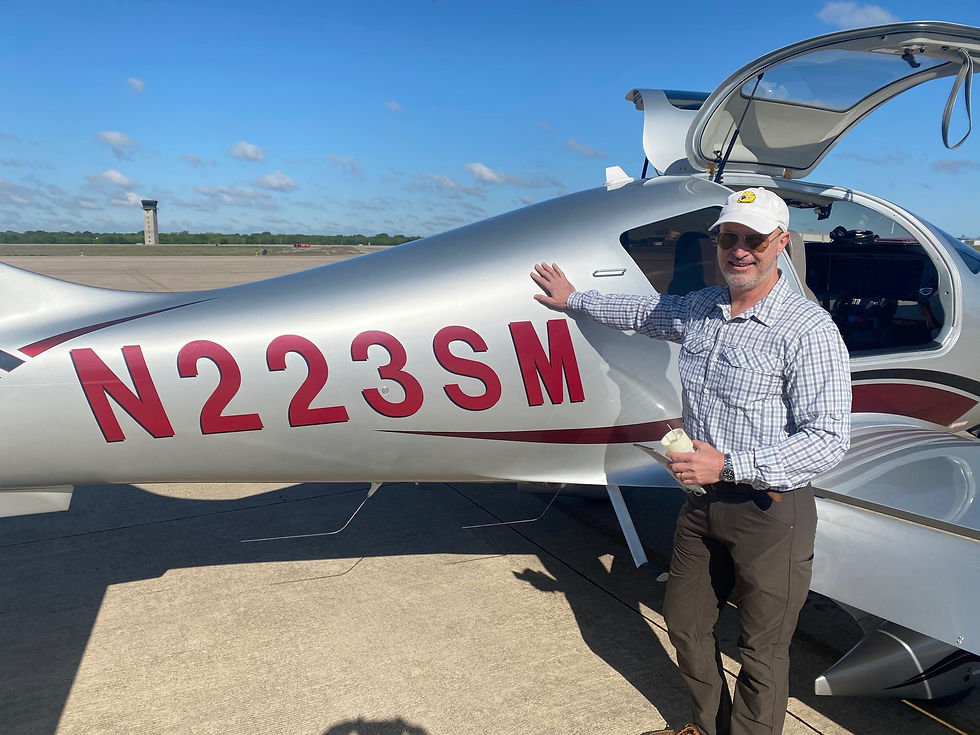
The first leg was the most worrisome for me. I managed to get the engine started after several tries--this is a cold-starting beast, it seems--then amazed myself by managing to program the SID into the GPS and have it loaded and ready to go once I was in the air.
Takeoff was uneventful, and soon I was getting vectors from Fort Worth approach control, taking me to the east. Wonderful. I'll just fly the heading bug, set the autopilot, and relax.
Not so fast. "Columbia Three Sierra Mike, turn left direct Triss intersection, then as filed."
Shit. Where's "Triss"? How do I find it on the nav panel? I meander like an airborne drunk to the north, remembering my original planned departure was up there somewhere.
"Three Sierra Mike, are you flying direct Triss?"
"Looking for it right now, approach."
"It should be part of your flight plan. In the meantime, come left to 030."
"030 for Three Sierra Mike."
I gratefully roll out on his vector while I fumble around on the multifunction display. I hit the flight plan button. My route pops up. I see Triss on the list of waypoints. Excelsior! I reach down to scroll to Triss, but when I get there hit the wrong button and end up in another screen. Damn! Start over. Flight plan. Activate cursor. Scroll to Triss. This time hit the "direct to" button. Hit "enter".
The primary flight display swings around and shows its new destination. The autopilot begins to maneuver us toward Triss. I exhale.

The next crisis on the trip is less about technology and more about the poor, poor decision to have a couple cups of coffee and take a Diet Dr. Pepper with me on the flight. It will be four hours and some change to Cincinnati Lukens Field, and the restroom facility on the Columbia consists of the empty Coke Zero bottle on the seat behind me. I decide instead to John Wayne it to Lukens rather than arriving with a bottle of pee in my flight bag. It is uncomfortable, but I manage.
Here's me using sunglasses to disguise the fact that the whites of my eyes have turned yellow.
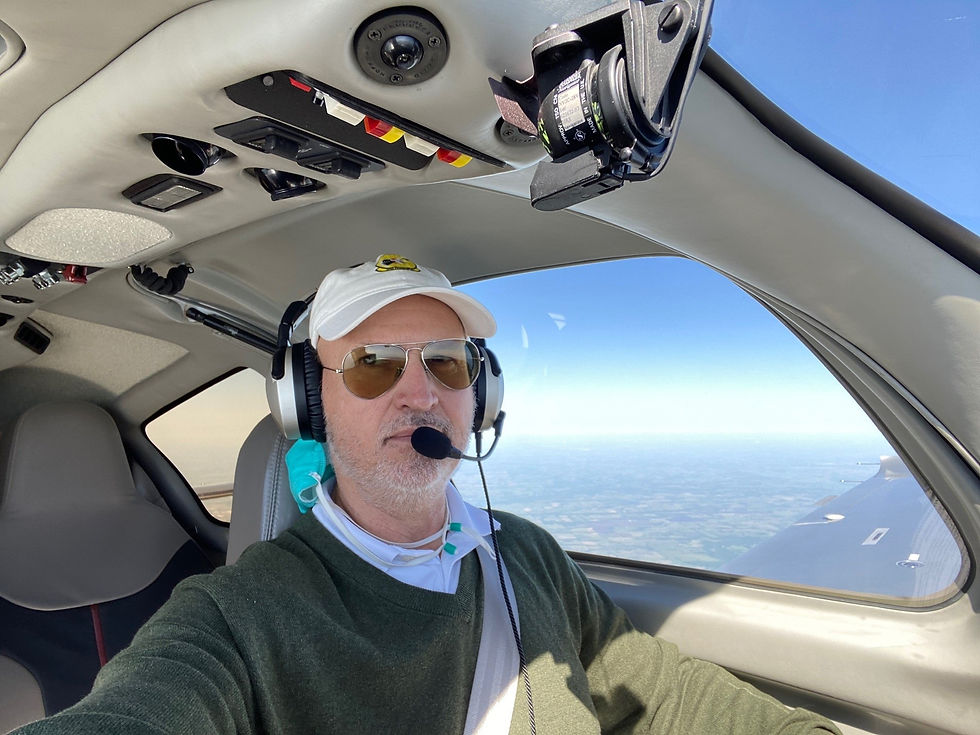
The weather all the way to Cincy is beautiful. I fly south of the Ozarks, across the vast brown flatness of eastern Arkansas, then past the confluence of the Mississippi and Ohio, which I tried unsuccessfully to photograph.
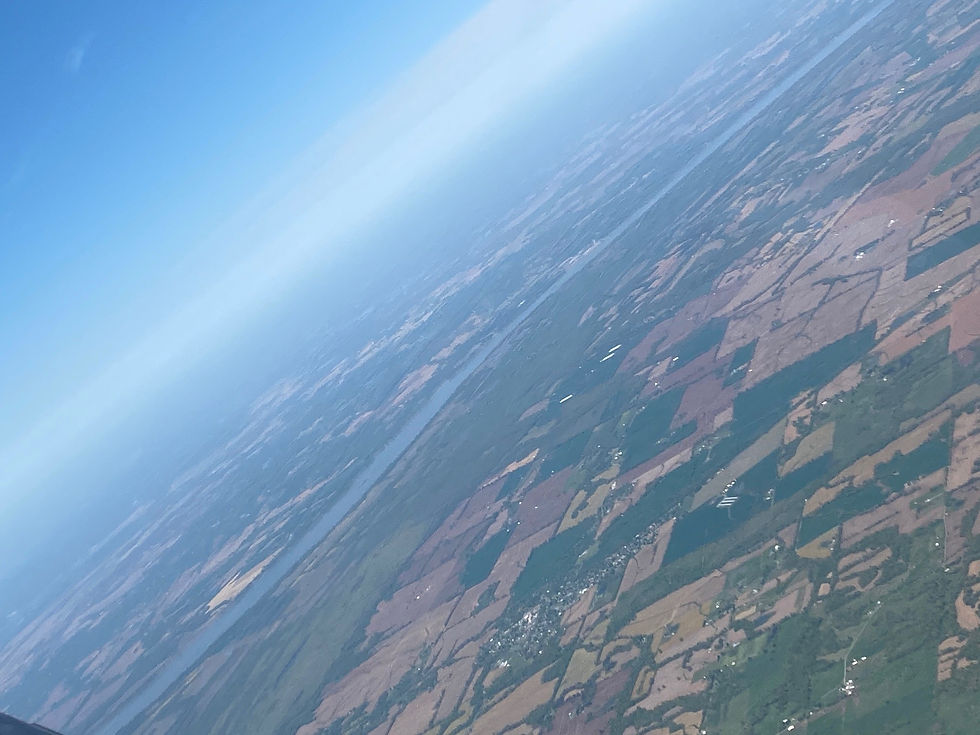
Even without the forecast headwind, Three Sierra Mike is clipping along at a nice pace, doing 180 true on 16 gallons an hour. I fly over Paducah and follow the Ohio to Cincinnati.
The approach into Lukens, a very busy general aviation airport tucked in a little cradle of hills just north of the Ohio, is uneventful. The landing is--ahem--ugly. Just ugly. I flare high, pull power, and sink with a crash onto the runway. Thankfully my pride is the only thing damaged, as I'm sure all the other pilots milling around must've chuckled a little at the super fancy plane pranging the concrete. Bet it's a doctor at the controls.
I manage a very fast turnaround at Waypoint Aviation, a nice family-run FBO with free ice cream (I didn't partake, however), which is good because the enthusiastic weather briefer on the phone says there is weather heading into Elmira, and the possibility of icing on arrival. Perfect.
After winning an aviator humanitarian award by cutting off a medevac jet to call number one for departure, I fly an uneventful climb and turn to the northeast and home. The route passes Columbus and Pittsburgh, as a thick broken layer develops below me. That's where one would find the ice, I surmise.
A little under two hours later I am about thirty miles from ELM, and approach descends me through that broken deck. The plane says it's about 25 degrees out there--perfect icing weather. I am not sure if I am actually seeing ice forming on the wings, but taking no chances I turn on propeller heat and activate 3SM's anti-icing system, which dribbles antifreeze over the tops of the wings. Nice to have those things at a moment like this.
I pop through the clouds and see that it's gorgeous over toward ELM. As I'm being vectored for the approach, just above the hills, I'm getting knocked around by turbulence, and I see that the G1000 says we have thirty knots of tailwind. Then twenty. Then thirty again.
As forecast, it was gusty as hell out there. After my last landing, I'm a little concerned about getting the plane down on the deck in this bumpy, windy environment.
But sometimes the blind hog finds the acorn. I keep my power up on short final to compensate for the gusty winds, fly the plane down just above the concrete, yank the power and flare. It is a landing for the ages, damn near perfect. I exhale.
"Three Sierra Mike, exit Runway 28 at Alpha, then via taxiway Bravo to the ramp. Remain this frequency."
"Three Sierra Mike will exit Alpha."
"Three Sierra Mike, you need to read back the whole clearance."
What a twerp, this little tower policeman. I just made maybe my best landing ever in the Columbia, in some really nasty and unpredictable conditions, and you're worried I didn't read back my taxi route. YGBSM.
I pull up to the hangar, see Peg standing at the fence huddled against the howling wind, and realize there's no one else here. I call on the radio. I call again. Nada.
Finally I shut down and call them on the phone. I'm told the attendant had to go run an errand, and will be back soon. I chat with P through the fence.
Finally our savior shows up and unlocks. Peg crawls around and into the plane. Peg approves of the plane, although the glove box in the center console will only accommodate maybe a half-dozen lipsticks. The hangar doors open, and we make small talk with the attendant about how much everything costs on an airplane. Yes, yes it does.
Here's me fumbling around with the gust lock while P says to smile for the camera.
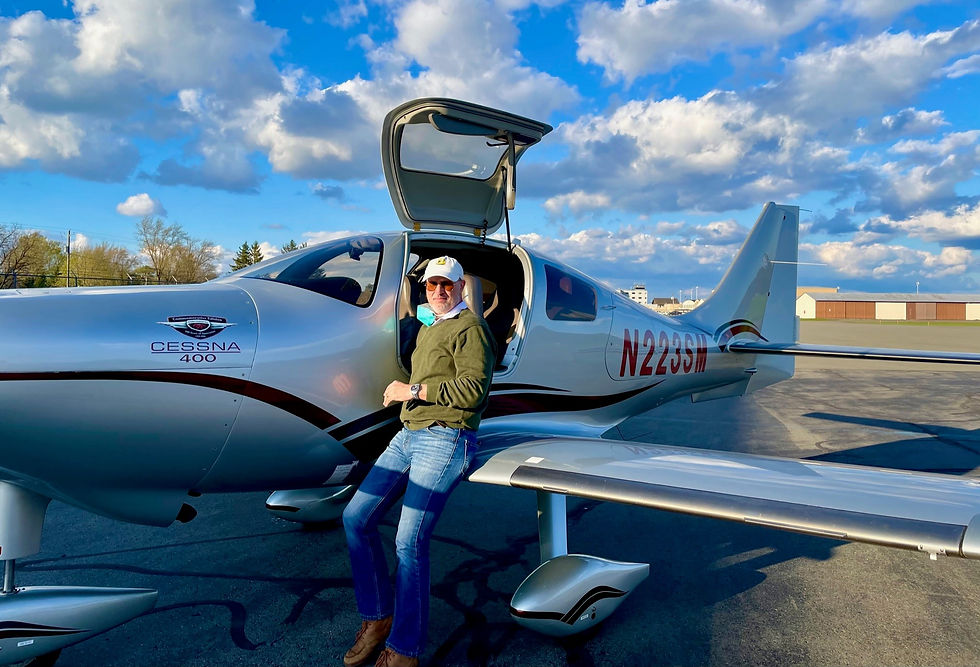
With that, my most intense training experience for over thirty years drew to a close. I learned a lot, got back in touch with my human limitations, and resolved to take seriously Skip's admonition to study more and do this right. The Columbia was precisely as advertised--fast, complex, and fun to fly. The role of the pilot is a radical departure from the Cardinal, or even my Air Force flying experience, in that I mostly just monitor instruments from the time I activate the autopilot passing 400 feet AGL until I kick it off somewhere on final approach. Not a lot of actual hand-flying, but that's fine. I'm no Maverick, and Hal flies the airplane more precisely than I ever could. It's just a new way of doing things.
Back to reality--mediating as the mediator in a few minutes.
Comments